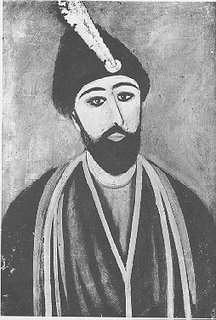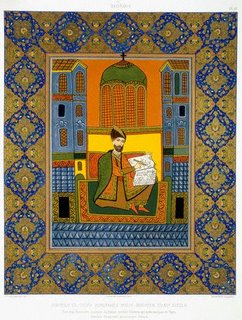Niko Pirosmani, Rustaveli
 (Click here for the Romanian version)
(Click here for the Romanian version)He who created the firmament by the omnipotent might of his power,
Gave breath to all living creatures and to man spirits celestial,
Gave us the world to possess with all its unlimited varieties,
And Kings ordained by Him, each in His own image.
So begins the Prologue to The Knight in the Panther's Skin; these verses come to us from the XII-th century. Pirosmani would make the portrait of Rustaveli eight hundred years later.
There are no written records of Rustaveli's life. The only authentic record we possess is the manuscript of his epic poem. It would be printed much, much later, by 1712.
I sing of the lion whom the use of lance, shield and sword adorns,
Of Tamar, the Queen of Queens, the ruby-cheeked and jet-haired.
How shall I dare pay tribute to her in praiseworthy verses,
Whom to look upon is to feast upon the choicest of honey?
And so we find out that Rustaveli was a contemporary of Queen Tamar - venerated by Georgians - her epoch was the greatest in their history.
I, Rustaveli, whose heart is pierced through by his sorrows have threaded Like a necklace of pearls a tale told until now as a tale.
I have found this Persian tale, and have set it in Georgian verse
Until now like a peerless pearl it was rolled on the palm of the hand.
whose heart is pierced by his sorrows, this reminds me of the leitmotiv of the Parajanov's movie Color of Pomegranate, there a verse of Sayat Nova is repeated obsessively, My life was sorrow. Sayat Nova, another great poet of the region of Transcaucasia.
Thinking at Rustaveli and Sayat Nova, at Pirosmani and at Parajanov - their change of replicas throughout the centuries. Pirosmani made the portraits of Rustaveli and Queen Tamar. Sayat Nova came back to life after hundreds of years through Parajanov' s masterpiece. Later Parajanov would make Arabeskebi Pirosmanis Temaze (Arabesques on the Pirosmani Theme); I will try to write something in a couple of days about this movie.
In the Arabic tongue a lover is called a madman,
A lover must never reveal his love but keep it hidden.
I'm using here the English translation offered by Venera Urushadze.
What would have been the source for Pirosmani's image of Rustaveli? It is believed that one of the frescoes of the Georgian Monastery of the Saint Cross in Jerusalem depicts Rustaveli - of course, Pirosmani did not see that fresco (anyway, the fresco shows a man in his old ages - it seems that Rustaveli ended his days at Jerusalem as a monk at that monastery).
Pirosmani should have known by instinct how to imagine his hero - they both belonged to the same cultural area - a national culture carries a living spirit flowing through centuries and inspiring the artists.
All at once they saw by the stream a stranger sitting and weeping.
He held a black horse by the bridle and looked like a lion and a hero.
His armour, saddle and bridle were thickly studded with pearls.
The rose was frozen by tears that welled up from his grief-stricken-heart.
The fresco on one of the pillars of the Monastery of the Cross has the hieratic style of any Eastern Christian icon – the painter of the XIIth century was interested only in the essence, the longing for the likeness with the Image of God. In 1852, a French artist, Fliert, tried also to render the image of Rustaveli, based on an old Georgian manuscript.


(Icon and Orthodoxy)
(Pirosmani)
Labels: Pirosmani

0 Comments:
Post a Comment
<< Home